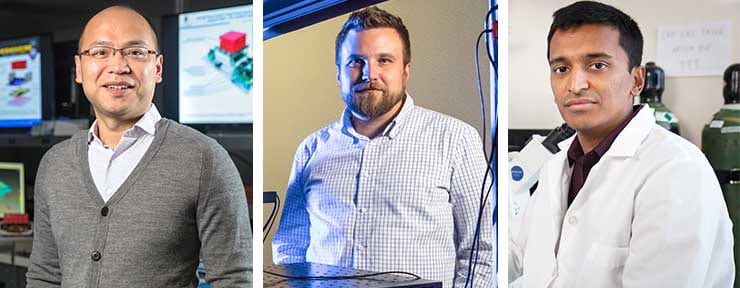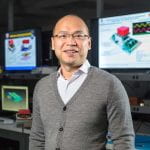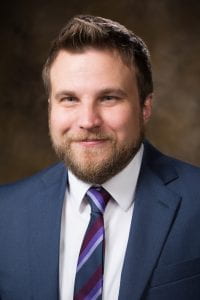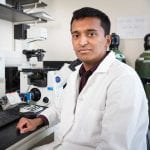FANG LUO, assistant professor of electrical engineering, received $296,804.
Luo’s award will support his research and teaching related to semiconductor-based electromagnetic interference mitigation. It’s a problem that is becoming increasingly prevalent as engineers work to make electronics smaller, faster and more efficient.
One way to make an electronic device more efficient is to improve how it switches between alternating (AC) and direct currents (DC). Improving the switching process can mean less energy is lost with each switch, devices can sustain faster switching for higher frequencies and higher temperatures.
The problem is, switching quickly can cause all sorts of undesirable side effects, which can impact neighboring parts of a device.
The issue is holding back modern electronics design for devices ranging from cell phone chargers to electric vehicle batteries. As designers find ways to make switching even faster, Luo hopes to find solutions to new problems that come along with the progress.
“I’m basically trying to solve the side effects caused by new technology,” he said. “When I was a student just working with silicon, we were told there was no ideal switch,” Luo said. “But now, we have the chance – the new device is so ideal, we’re getting there.”
But in getting so close to an ideal switch, researchers are encountering never-before-seen side effects.
Near-ideal switches in power electronics converters generate a lot of noise that can travel through the entire power electronics system and interfere with other parts of the device/system. Researchers have considered a variety of ways to deal with that interference, but for Luo, the answer lies within the semiconductor itself.
“Since we’re seeing those high-frequency noises being caused by semiconductors,” he said, “why not use the semiconductors themselves to solve the problem?”
The idea works like a noise-cancelling headphone, just at a much higher frequency. Luo plans to take the noise produced by the switch and re-inject it back into the system before it can interfere with the rest of the device.
Luo also plans to use his funding to teach a new course focused on electromagnetic interference, a topic that typically only receives a cursory mention in electrical engineering curriculum, but Luo said it can play a critical role in the success of a real-world project.
KYLE QUINN, assistant professor of biomedical engineering, received $500,000.
His CAREER award is focused on monitoring cell metabolism over time and understanding the role mitochondria play in age-related diseases like Alzheimer’s, cardiovascular disorders, cancer, diabetes and obesity.
“Mitochondria are the powerhouse of the cell, they’re the energy producing structures.” Quinn said. “We’re trying to understand how dysfunction arises with age. There can be a difference between someone’s chronological age versus their biological age. It’s this idea that aging affects us all in different ways, and consequently, the function of our cells can change in different ways.”
Quinn is looking to use novel optical imaging approaches to develop an understanding of how mitochondria change over a lifetime. The hope is to unlock new information about how age-related diseases develop, which could provide clues into how those diseases could be treated or prevented.
“We don’t have tools to non-invasively assess how age-related changes to our cells can occur and when they’re occurring and what that means for certain diseases,” Quinn said. “It’s hard to tease out age-related problems versus all the other things that occur when you have a medical issue.”
It’s important to monitor mitochondria, Quinn said, because the structures demonstrate a variety of changes throughout the aging process.
“With increasing age, there are increasing internal stresses on your cells and mitochondria,” he said. “There is an accumulation of damage to different cell components produced by highly reactive molecules called free radicals, and the mitochondria become less efficient.”
“Mitochondria are dynamic. They fuse together; they break apart. The cell will cordon off dysfunctional mitochondria. But, a lot of those dynamics have been reported to change with age.” Being able to track those changes accurately could provide critical information about the nature of aging.
The research isn’t specific to one disease, and that’s by design.
“This is very much a basic science type of grant – it’s broadly applicable. There are all these different problems in neurodegenerative diseases, cancer, and diabetes where mitochondria can become dysfunctional, and we could have some really broad, transformative impacts,” Quinn said.
Quinn’s grant includes funding to support outreach activities.
Quinn’s project will be to expand the summer camps offered by the Department of Biomedical Engineering, which are designed to expose K-12 students from across Arkansas to science, with a particular focus on groups that are typically underrepresented in engineering.
NARASIMHAN RAJARAM, assistant professor of biomedical engineering, received $500,000.
The funding will allow Rajaram to dive deeply into the root of radiation resistance in tumors.
In 2019, it’s almost a cliché to say everyone knows someone whose life has been impacted by cancer.
Narasimhan Rajaram knows that. He knows that because he’s been conducting cancer research since he started as a graduate student at the University of Texas at Austin in 2005. But he also knows that because when he was an undergrad in India, the woman who would become his mother-in-law was receiving aggressive radiation therapy for ovarian cancer.
Rajaram’s research centers on head and neck cancer, but the idea has broad implications. If researchers can understand why some tumors become radiation-resistant and others don’t, they might be able to switch patients with resistant tumors to other radiation treatment strategies earlier and potentially improve the effectiveness and efficiency of cancer treatments.
Radiation treatment uses intense beams of energy to kill cancer cells. It’s used to treat nearly every type of cancer, and more than half of patients with cancer receive the therapy as part of the treatment process, according to the Mayo Clinic.
The beam of radiation is focused, much more focused than chemotherapy, but it’s not perfect. Sometimes organs near the site of the tumor sustain collateral damage.
“Radiation therapy has advanced quite a lot these days,” Rajaram said. “Now, it is pretty focused, and you can spare a lot of normal tissue. But, for example, with head and neck cancer, radiation has strong effects on normal tissue, such as the salivary glands.”
The research could also help doctors provide more appropriate doses of radiation, potentially reducing or avoiding damage to normal tissue, Rajaram said.
Rajaram and his team are working to identify a way to tell which tumors will respond to radiation treatment and which ones will not by building an instrument that can look at a tumor’s oxygen supply, how that oxygen is being used and what that means for the cell’s metabolism.
CAREER funding will also allow him to share his knowledge of optics and imaging with middle schoolers across Arkansas by building imaging-based kits that can be sent to teachers throughout the state to work into their lessons. The kits include content to help teachers expand on age-appropriate topics already in the curriculum.




